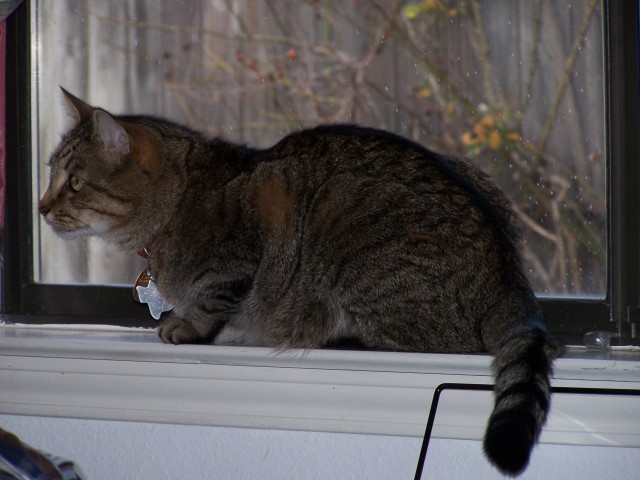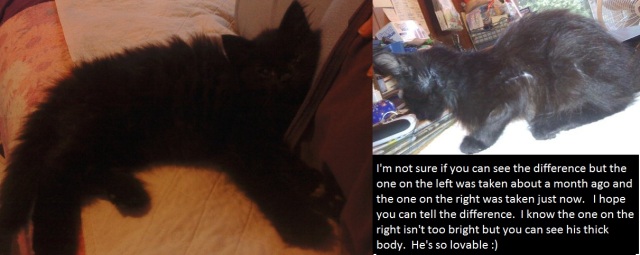QuestionWeekend before last a cute stray kitten wandered into my yard. He (I think) is dark & light orange striped with blue eyes like a siamese. I have the following questions: At what age should I plan on getting him his shots? Also, when should he be neutered? Is there any sure fire way to tell a male kitten from a female? Last, on his left paw I noticed after a few days that it looked like the fur had been scraped away around his middle claw. Now the area on either side of the claw and the pad underneath are swollen. I've soaked the paw in hydrogen peroxide and in chlorhaxidine scrub for the last few days, but it's not getting any better. I've inspected the area as best I can, and I don't see anything infected, just swollen. He walks on all four paws and doesn't limp.
Thanks,
Mae
AnswerHi Mae. Congrats on your addition! I'll answer your questions in order.
Q. At what age should I plan on getting him his shots?
A. This will vary, depending on your vet's opinion. Some start as young as 6 weeks old with vaccinations against distemper, calici virus and herpes
virus. Others (and most in my experience) wait until 8 weeks. Some still prefer to wait until 12 weeks.
Rabies is another ball of wax. Most vets wait until 16 weeks, although some will do it as young as 12 weeks and some will wait as long as six months.
If the kitten will go outside at all, he should be vaccinated against feline leukemia, too. This is now the deadliest disease in domestic cats, thanks to the development of an effective distemper vaccine. Leukemia is passed mainly through saliva contact (mutual grooming or fighting) and is very widespread in the U.S. A leukemia vaccine should be given after the cat has tested negative for the disease on a simple blood test, at no younger than 12 weeks old.
To complicate things, each vaccination will need a booster, and how many booster shots your kitten should receive will depend on the vet's preference, as well. But plan to give the kitten at least one booster shot for distemper, herpes and calici, one month after the first.
Q. Also, when should he be neutered?
A. Pretty much any time. Neutering kittens older than 8 weeks and weighing over 2 pounds is now performed routinely and safely. I personally have my cats, male and female, neutered between the ages of two and four months,
because while uncommon, some cats have been known to sexually mature at just 4 months old. Some more conservative vets prefer to wait until the kitten
is 6-9 months. Unfortunately, I've seen many litters result from waiting this long - one in my own cat! So I always recommend to neuter early.
There are no ill effects on health or development.
Q. Is there any sure fire way to tell a male kitten from a female?
A. Yes, though it becomes easier to tell with age. Of course, you'll need to look under the kitten's tail. The anus should be obvious. In a male, you will see a flap of skin just below the anus, which is the scrotum. If the kitten is 8-12 weeks or older, then testicles should be pretty obvious, too. And just below that, you will see a round, slightly raised opening.
With a female, you will notice a narrow verticle opening just below the anus. This appears as a small slit and is pretty well flush with the surrounding skin. Here are pictures of both male and female kittens that may help you:
http://www.vetmed.wsu.edu/cliented/kittensex.asp
Q. Last, on his left paw I noticed after a few days that it looked like the fur had been scraped away around his middle claw. Now the area on either side of the claw and the pad underneath are swollen. I've soaked the paw in
hydrogen peroxide and in chlorhaxidine scrub for the last few days, but it's not getting any better. I've inspected the area as best I can, and I don't see anything infected, just swollen. He walks on all four paws and doesn't limp.
A. As a general rule, peroxide shouldn't be used on cats. Oddly enough, in cats, it delays healing and causes swelling and inflammation. It actually produces heat within the wound. Chlorhexidine flush is perfect. I
suggest to dilute it with water (1 part chlorhexidine to 10 parts warm water) and use it as a soak for as long as the kitten will allow - 10 to 15 minutes would be ideal, 2-3 times daily.
However, bear in mind that this will not necessarily get rid of ringworm, a highly contagious fungal infection that is extremely common in kittens. It also is not going to take care of an injury or a bacterial infection beneath
the skin, or mite infestations. So personally, I would recommend having the vet look at it ASAP. Chances are very good the little guy (or girl) also needs to be dewormed and looked over for ear mites, fleas and such.

 2 Ferals
Question
Sister and Brother at
Hello!
Im so glad I fo
2 Ferals
Question
Sister and Brother at
Hello!
Im so glad I fo
 Identify Cat Breed?
Question
picture of my cat picture of my cat &nbs
Identify Cat Breed?
Question
picture of my cat picture of my cat &nbs
 Cat gets angry at tail
Question
Rascal Rasputin
My indoor adult cat seems to g
Cat gets angry at tail
Question
Rascal Rasputin
My indoor adult cat seems to g
 Kitten lossing weight drastically
QuestionTubby before and after
QUESTION: Hello.
Kitten lossing weight drastically
QuestionTubby before and after
QUESTION: Hello.
 Persian Male Behavioral Issues.
Question
Jimmy
Dear Karen
Hope you are fine. I
Persian Male Behavioral Issues.
Question
Jimmy
Dear Karen
Hope you are fine. I